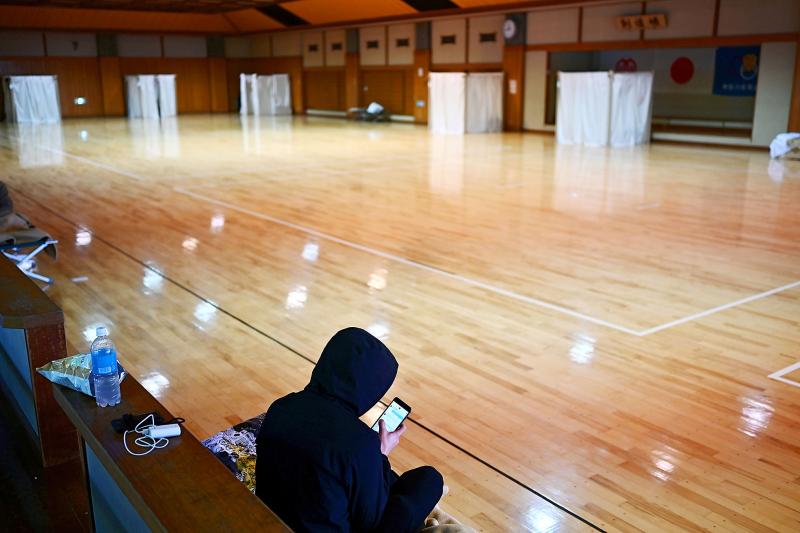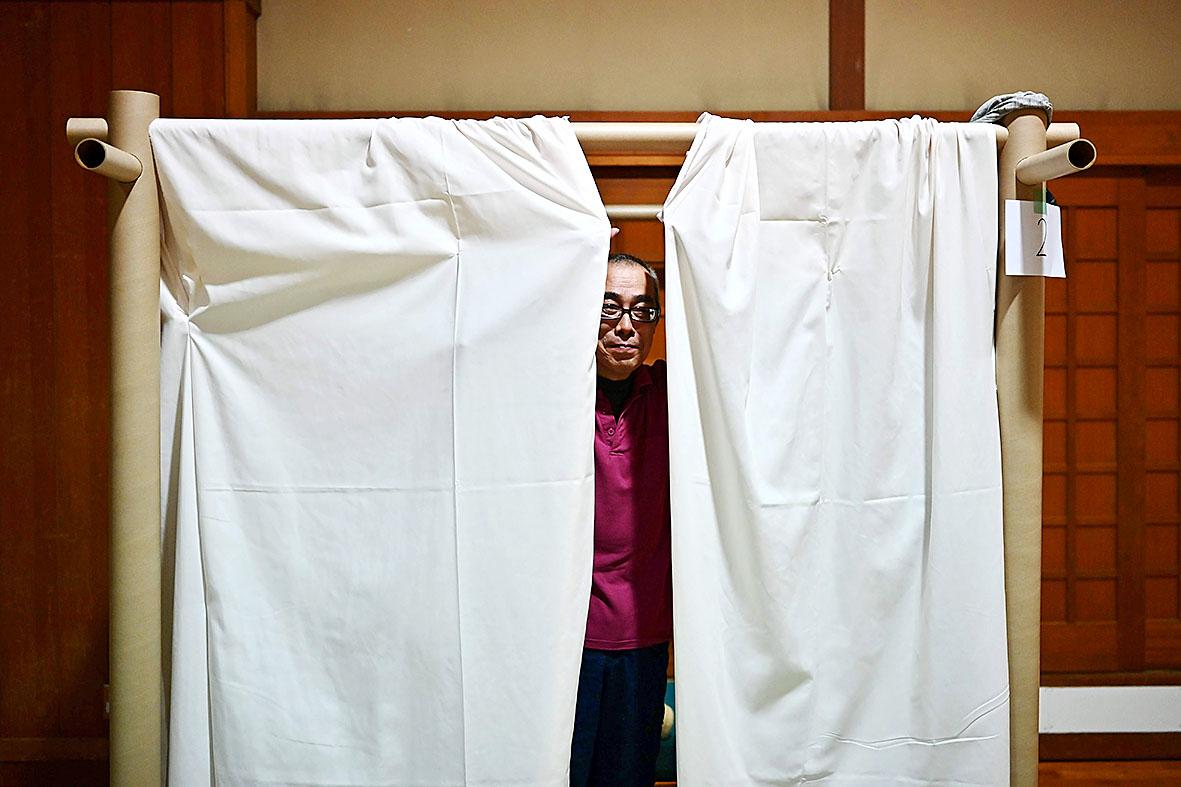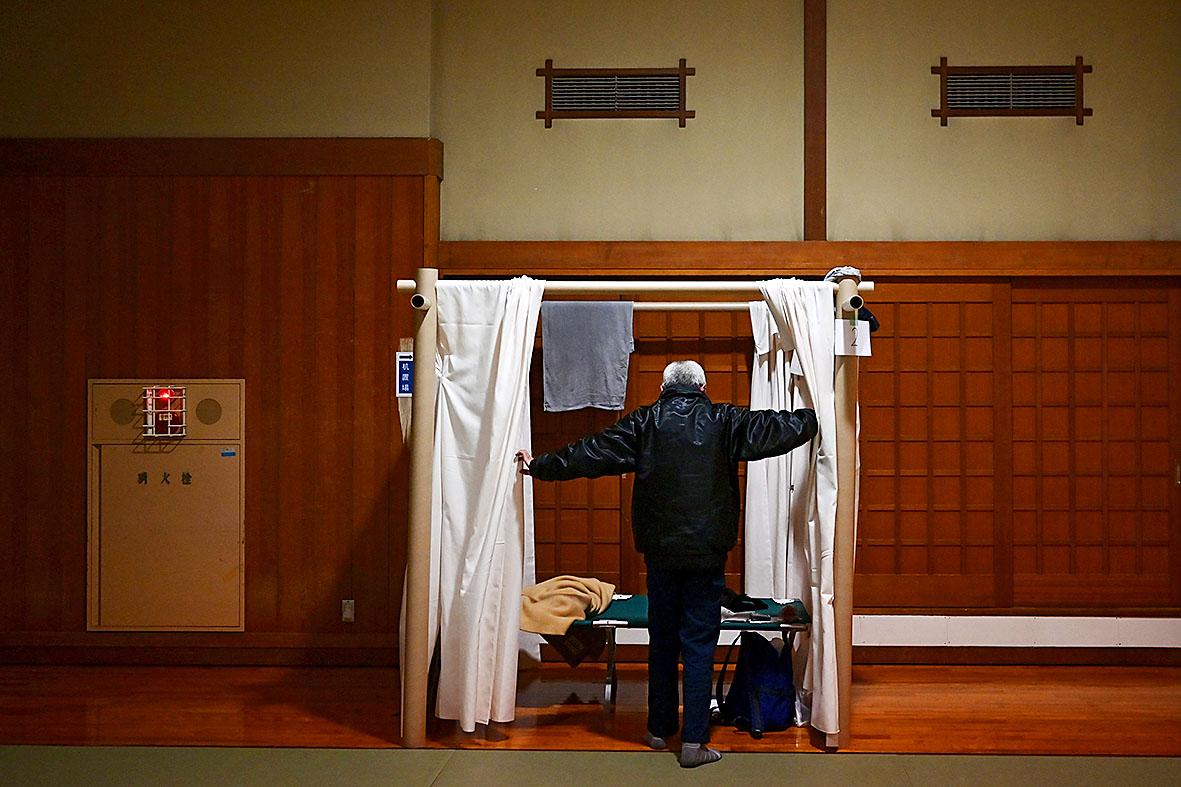Thousands of homeless “net cafe refugees” in Japan risk being turfed out onto the streets as the coronavirus pandemic forces the sudden closure of their uniquely Japanese 24/7 comic book havens.
The ubiquitous all-night internet and “manga” comic cafes offer couches, computers, comics, soft drinks and shower facilities for an overnight stay typically priced around 2,000 yen (US$18).
An estimated 4,000 people down on their luck make their home in such cafes in Tokyo alone, and activists worry that shutting them down could lead to suicides and a spike in rough sleepers.

Photo: AFP
Some local authorities are now opening shelters to accommodate “net cafe refugees” and keep them from sleeping out in the open.
One 58-year-old occasional construction-site worker said his main aim was “avoiding getting wet,” as he found a roof over his head at a shelter converted from a martial arts center in Yokohama near Tokyo.
“I thought of sleeping on a bench at a train station... or subway stairs going underground,” said the grey-haired man, who declined to give his name.

Photo: AFP
His net cafe informed him at the weekend it would be closing due to state of emergency measures in Japan to stem the spread of the coronavirus.
“I used to go to work from net cafes... now I sometimes have a job, sometimes not, due to the coronavirus,” he said, adding that it was nearly impossible to find a permanent job at his age.
Renting an apartment in Japan requires a very expensive deposit and presents tricky administrative hurdles, leaving net cafes a convenient option for many of the country’s hidden poor.

Photo: AFP
“I have nowhere to go to, few acquaintances,” said the man.
‘DISCREET AND QUIET’
The temporary shelters at the judo hall in Yokohama, operated by the local Kanagawa authorities, have been designed by a team led by award-winning Japanese architect Shigeru Ban to offer privacy and prevent infections.
Residents sleep on camp-style cots or cardboard beds partitioned off by a frame of sturdy paper tubes with cloth hanging from the top of the cubicle to the floor.
Ban is famed for other emergency shelters and buildings, including the Cardboard Cathedral for Christchurch in New Zealand after the 2011 earthquake.
The aim is to provide a safe place to those driven out by the coronavirus crisis, said Yuji Miyakoshi, an official at the municipal government.
The free shelter has hosted nearly 40 people since opening on Saturday and one resident said it had been proved invaluable after his “capsule hotel” accommodation closed two days ago.
“I went to work, slept at the hotel and went back to work. I moved to this place but nothing has changed so much,” said the man in his 30s who works in construction.
Miyakoshi said the people in the shelter were “quite discreet and quiet... My feeling is that many of them are obviously not good at asserting themselves.”
‘UNSAFE HOUSING CONDITIONS’
On the surface, Japan appears a wealthy and prosperous society and visitors to Tokyo and other major cities are often struck by the relative lack of homeless people seen in other world capitals.
The Japanese economy bounced back from a recession in the 1990s, creating millions of new jobs, but critics said many of them were temporary and created a new class of urban poverty.
The manga cafes were initially a haven for late-working — or late-drinking — business people from far-flung suburbs who missed the last train home, but eventually became a shelter for Japan’s working poor.
Coronavirus has driven these people into a corner, said Tsuyoshi Inaba, who has long been involved in helping homeless people.
Inaba estimates there are already 2,000 homeless in Tokyo — double the official figure — as public surveys conducted during the day often miss people sleeping rough at night after a day’s work.
Combined with 4,000 net cafe refugees, “some 6,000 people are in unstable, unsafe housing situations” in Tokyo alone, Inaba said.
The Tokyo Metropolitan Government, which ordered establishments such as net cafes closed amid a spike of coronavirus cases in the capital, is trying to find a solution for the hundreds abruptly made homeless.
But activists say not enough accommodation is being provided and that the conditions are too onerous — such as requiring applicants to prove they have been in Tokyo for six months or longer.
Many kicked out of net cafes have no option but to sleep on the street if they can’t find a proper shelter, Inaba said, adding: “This could cause social confusion and suicides are feared to increase.”
If official aid remains inadequate, Inaba foresees a “big problem” that could even contribute to a further spreading of coronavirus.
“Some people could move to provincial cities despite the possibility that they may have the virus,” he warned.

Oct. 27 to Nov. 2 Over a breakfast of soymilk and fried dough costing less than NT$400, seven officials and engineers agreed on a NT$400 million plan — unaware that it would mark the beginning of Taiwan’s semiconductor empire. It was a cold February morning in 1974. Gathered at the unassuming shop were Economics minister Sun Yun-hsuan (孫運璿), director-general of Transportation and Communications Kao Yu-shu (高玉樹), Industrial Technology Research Institute (ITRI) president Wang Chao-chen (王兆振), Telecommunications Laboratories director Kang Pao-huang (康寶煌), Executive Yuan secretary-general Fei Hua (費驊), director-general of Telecommunications Fang Hsien-chi (方賢齊) and Radio Corporation of America (RCA) Laboratories director Pan

The classic warmth of a good old-fashioned izakaya beckons you in, all cozy nooks and dark wood finishes, as tables order a third round and waiters sling tapas-sized bites and assorted — sometimes unidentifiable — skewered meats. But there’s a romantic hush about this Ximending (西門町) hotspot, with cocktails savored, plating elegant and never rushed and daters and diners lit by candlelight and chandelier. Each chair is mismatched and the assorted tables appear to be the fanciest picks from a nearby flea market. A naked sewing mannequin stands in a dimly lit corner, adorned with antique mirrors and draped foliage
The consensus on the Chinese Nationalist Party (KMT) chair race is that Cheng Li-wun (鄭麗文) ran a populist, ideological back-to-basics campaign and soundly defeated former Taipei mayor Hau Lung-bin (郝龍斌), the candidate backed by the big institutional players. Cheng tapped into a wave of popular enthusiasm within the KMT, while the institutional players’ get-out-the-vote abilities fell flat, suggesting their power has weakened significantly. Yet, a closer look at the race paints a more complicated picture, raising questions about some analysts’ conclusions, including my own. TURNOUT Here is a surprising statistic: Turnout was 130,678, or 39.46 percent of the 331,145 eligible party

The election of Cheng Li-wun (鄭麗文) as chair of the Chinese Nationalist Party (KMT) marked a triumphant return of pride in the “Chinese” in the party name. Cheng wants Taiwanese to be proud to call themselves Chinese again. The unambiguous winner was a return to the KMT ideology that formed in the early 2000s under then chairman Lien Chan (連戰) and president Ma Ying-jeou (馬英九) put into practice as far as he could, until ultimately thwarted by hundreds of thousands of protestors thronging the streets in what became known as the Sunflower movement in 2014. Cheng is an unambiguous Chinese ethnonationalist,